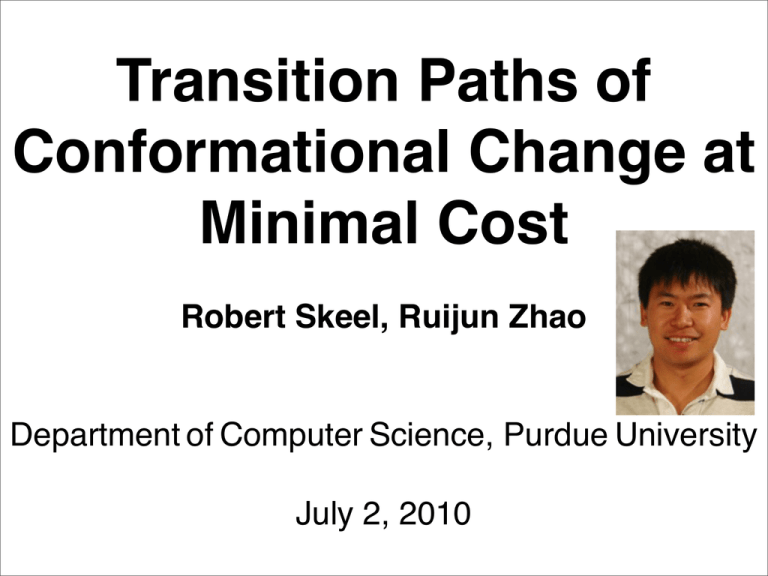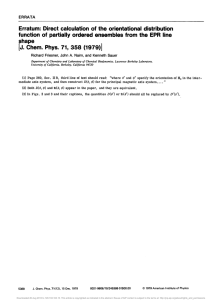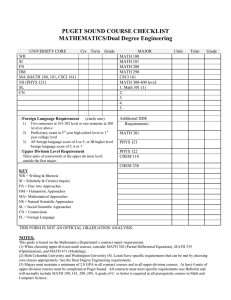Transition Paths of Conformational Change at Minimal Cost Robert Skeel, Ruijun Zhao
advertisement

Transition Paths of Conformational Change at Minimal Cost Robert Skeel, Ruijun Zhao Department of Computer Science, Purdue University July 2, 2010 Outline Motivation Objective Summary Some Numerical Results Some Details - the geometric property - a key assumption - implementation Remarks Motivation! Catalytic domain of Src Tyrosine kinase inactive! active! N-lobe! N-lobe! α-helix C! α-helix C! A-loop! A-loop! C-lobe! C-lobe! Biological questions How does the mechanical signal of unbinding at an allosteric site transmit through the molecule to induce conformational change in the active site? What are possible intermediate states involved in the transition that can be used as targets for drug design? What is the free energy difference between the two conformational states? Molecular dynamics! Assume molecular system obeys Newtonian dynamics where M is atomic masses and U(x) is potential energy. Initial values of positions x and velocities are drawn from the canonical ensemble with inverse temperature β. Objective Compute for minimal cost best possible representative paths of conformational change from conformation A to conformation B. Representative path: center of an isolated cluster of trajectories. Clustering might occur only with the use of a reduced set of collective variables (colvars): ζ1 = ξ1 (x), ζ2 = ξ2 (x), . . . , ζncv = ξncv (x) e.g., phi and psi dihedrals for alanine dipeptide. Minimal cost: sampling is limited to the path in colvar space. (Also, minimal programming effort through use of existing features of simulators.) Best possible: narrow tube (of constant cross-section area) that maximizes flow rate of reactive trajectories—assuming trajectories are confined to the tube. Summary Define the free energy function F by exp(−βF (ζ)) = ρξ (ζ) where ρξ(ζ) is the probability density function of ζ = ξ(x), the tensor D by � � D(ζ) = mtot ξx M −1 ξxT ξ(x)=ζ and the norm |ω|ζ = (ω D(ζ) T −1 1/2 ω) The formula The maximum flux transition path (MFTP) ζ = Z(s), 0 ≤ s ≤ 1, minimizes �1 1/2 exp(βF (Z))(det D(Z)) |Zs |Z 0 ds. with Z(0) in conformation Aξ and Z(1) in conformation Bξ, where Z = Z(s) and Zs = (d/ds)Z(s). derived using transition path theory many minima For Comparison Minimum resistance path (MRP) minimizes �1 −1 2 exp(βF (Z))|Z | |Z | s s Z ds. 0 Path depends on how colvar space is parameterized (see The geometric property). Berkowitz, Morgan, McCammon and Northrup. J. Chem. Phys., 1983. Huo and Straub. The MaxFlux ..., J. Chem. Phys., 1997. Minimum free energy path (MFEP) minimizes �1 |D(Z)∇F (Z)|Z |Zs |Z ds. 0 Maragliano, Fischer, Vanden-Eijnden, and Ciccotti, J. Chem. Phys., 2006. Vanden-Eijnden and Heymann. J. Chem. Phys., 2008. Minimum free energy path (MFEP) neglects finite temperature effects–in the explicit degrees of freedom. alanine dipeptide (OPLS-AA with GBSA) MFEP & MRPs density of paths from TPS Jiménez and Crehuet, Theor. Chem. Account, 2007. The MFTP is computationally most attractive: The MRP has complicated dependence on Zs. The MFEP has cusps and its minimization formulation may be impractical. minimization principle is an advantage The M(F)EP with increasing resolution Some Numerical Results Three hole potential The MFTP at different temperature (1/β in kcal/mol) and the minimum energy path (MEP). The contour lines are separated by 0.25 kcal/mol. Alanine dipeptide The MFTP and the MFEP for alanine dipeptide in vacuum at 300 K.The colvar space is phi/psi dihedrals. The contour lines are separated by 0.6 kcal/mol. Solvated alanine dipeptide Alanine decapeptide alpha helix to pi helix transition Energy along a selection of low energy paths Chu, Trout, & B. Brooks, J. Chem. Phys., 2003. Free energy along maximum flux transition path using alpha carbons Some Details The geometric property Point in collective variable space = hyper-surface in configuration space The geometric property means that if we instead minimize the integral using variables ' ' " = # (x) = $ (#(x)) then the resulting path ζʼ = Zʼ(s) will satisfy Zʼ(s) = χ(Z(s)). e.g., squaring colvars that measure distance yields same path. This is achieved for the MFTP by using the metric tensor D-1 to define distance from ! ζ to ζ+dζ as |dζ|ζ (and using this metric to measure cross-section area). The MFTP is a geodesic with metric tensor exp(2βF (ζ)) det(D(ζ))D(ζ)−1 The others? Underlying assumption It is assumed that paths ζ = ξ(x(t)) are those of the Brownian dynamics d ζ dτ = −β D̄(ζ)∇F (ζ) + (∇ · D̄(ζ))T √ 1/2 + 2D̄(ζ) η(τ ) where η(τ) is white noise, τ is fictitious time, and the – diffusion tensor D is a rescaling of D. Role of committor The cross sections of the narrow tube are taken to be isocommittors because the surfaces of Aξ and Bξ are. Current implementation 1. free energy approximated using stiff restraints exp(−βF (ζ)) = ρξ (ζ) ≈ �δε (ξ(x) − ζ)� where δε (s) = (2πε2 )−1/2 exp(−s2 /(2ε2 )) e.g., ε = 1 degree Euler-Lagrange ``equationsʼʼ for the MFTP D(Z)−1 Zs � − β∇ζ F+ (Z, Zs ) + (D(Z)−1 Zs )s |Zs |2Z where 1 ncv −1 2 log(c0 det D(ζ)|ω|ζ ) F+ (ζ, ω) = F (ζ) − 2β 2. The simplified MFTP: Neglect derivatives of D orthogonal to the path: −1 D(Z) Zs � − β∇ζ F (Z) + (D(Z)−1 Zs )s |Zs |2Z 3. piecewise linear discretization of path; discretize Euler-Lagrange equation using upwinding 4. The semi-implicit simplified string method [5] is implemented. E, Ren, and Vanden-Eijnden. J. Chem. Phys., 2007. Vanden-Eijnden and Heymann. J. Chem. Phys., 2008. 35-50 iterations for alanine dipeptide. MFEP requires 25% more--if it has a cusp. 5. sampling performed using 50+500 ps of Langevin or NoseHoover dynamics per image per iteration. Remarks Reiterating A maximum flux transition path (MFTP) is the center of a narrow tube (of constant cross-section area) that yields the maximum reaction rate—if trajectories were confined to the tube. Claim: It is the best representation of trajectories obtainable at minimal computing cost with modest programming effort. An MFTP is a worthwhile improvement to an MRP / MaxFlux path * is more meaningful due to geometric property * produces no unpleasant surprises * requires no apologies * and costs only a little extra. Molecular simulators impede innovation * they ought to be callable from a popular scripting language, providing a variety of low-level functions, supplemented by a set of canned scripts. e.g, we have to continually reinvoke the program and would have to use named pipes to avoid disk accesses. * they ought to provide a broad array of basic functions: force fields, constraints & restraints, colvars and their derivatives, integrators & samplers, ..., e.g., we have to use tricks to get derivatives of colvars Computation is not the 3rd pillar Rather, theory and computation are extremes on a single spectrum of possible approaches. Notably, modeling of rare events cannot be studied by direct numerical simulation (DNS) alone. Additionally, it is better not to dilute the role of experiment. Computation is a tool of the theoretician (and experimentalist). Acknowledgments Juanfang “Janice” Shen, graduate student Carol Post Lab: Carol, He Huang Eric Vanden-Eijnden Jhih-Wei Chu NIH

